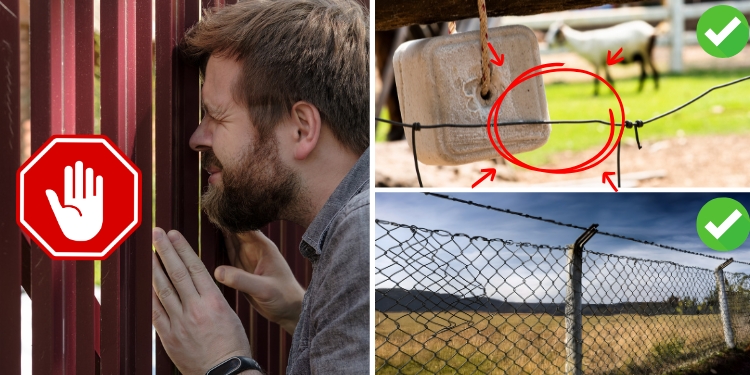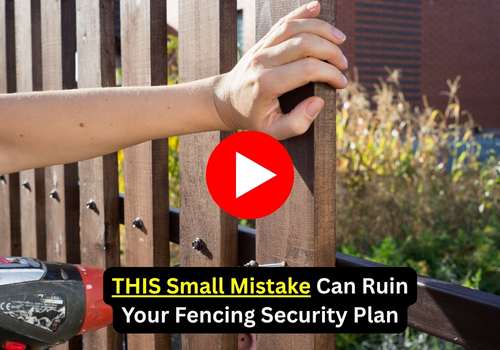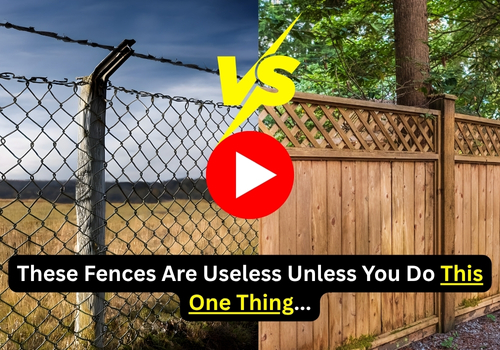Avoid THIS Fence at All Costs!

You’ve invested in food, water, and gear. But if you don’t have a fence, you’ve created a target with a wide-open invitation.
The truth is, your stockpile isn’t at risk only when disaster strikes, but it’s also vulnerable today, while the world is still struggling to stand. Unfenced properties advertise easy access, making them prime targets for casual theft and intrusion today. The right fence goes far beyond a property line; it is a layered security system, acting as a deterrent, a physical barrier, and an early detection tool.
But be warned: there is one common type of fence that looks secure but is virtually useless when true security matters.
The Fence That May Betray Your Security…
Is the chain-link. Even if this fence is affordable, easy to install, and durable, it often provides a dangerous illusion of protection. While it certainly marks your property line and offers excellent visibility, its woven wire structure presents numerous weaknesses that a determined intruder can exploit with alarming speed and ease.
 The open grid provides built-in handholds and footholds, making it simple to scale, and basic bolt cutters can silently breach the entire perimeter in minutes.
The open grid provides built-in handholds and footholds, making it simple to scale, and basic bolt cutters can silently breach the entire perimeter in minutes.
Relying solely on this type of fence means you have invested in a visible boundary, but you have fundamentally failed to establish a genuine, time-consuming deterrent.
This vulnerability means that for serious preparedness, a standard chain-link installation cannot be considered the final solution.
In a crisis, the fence is the first line of defense; if it can be easily bypassed, the rest of your security measures are immediately compromised.
While its low cost and durability make it appealing for enclosing large areas, preppers must recognize its inherent flaws and commit to upgrades. Adding features like privacy slats, reinforced materials, or deterrents such as barbed or razor wire are necessary steps to transform this budget barrier into a functional security measure that actually slows down a threat and gives you precious time to react.
Types of fences that every prepper should have
Wooden Privacy Fence
Wooden fences could keep neighbors or passersby from knowing just how well-stocked your property is and can also serve as a windbreak if your property is adjacent to an open field. However, the posts for the fence need to be firmly anchored, or whole sections can be pushed over.
If you live in an urban or suburban area, a wooden privacy fence is one of the best ways to maintain discretion. But certain areas and HOAs have strict rules about how a wooden fence must be installed and maintained. Make sure you know these, or you risk the fence drawing unwanted attention.
Meanwhile, find out if you’re making these mistakes when installing your fencing:

Pros:
- Provides excellent concealment of your home and property, keeping neighbors or passersby from seeing valuables.
- Can be designed to blend in with suburban neighborhoods, maintaining aesthetic appeal.
- Acts as a solid barrier that is more difficult to climb compared to chain-link fences.
- Can serve as a windbreak if your property is near open fields.
- Adds a sense of privacy and security, creating a defined boundary around your property.
Cons:
- Can be expensive, depending on the length, type of wood, and materials used.
- Requires regular maintenance to prevent rot, warping, and weather damage.
- Vulnerable to fire, especially in dry areas or during wildfire season.
- Posts must be firmly anchored, or sections can be pushed over, compromising security.
Pro Tip: Plant thorny landscaping like rose bushes or raspberries to add an effective deterrent while still looking “normal.”
Barbed Wire
Relatively cheap and effective at slowing or injuring anyone trying to cross it. Even so, it’s only really practical for rural preppers, where it’s often used to control livestock while also doubling as a perimeter deterrent. It’s also easy to add electric fencing wires to a barbed wire fence to further boost its deterrent value.
Pros:
- Highly effective psychological and physical barrier.
- Affordable and easy to deploy over large areas.
- Works well with other fence types for reinforcement.
Cons:
- Doesn’t provide privacy.
- Posts need a very firm foundation.
For serious prepping, barbed wire should rarely be your only fence type. Instead, it works best as a secondary or tertiary layer on top of chain-link or wooden fencing. In rural retreats, you can combine barbed wire with natural obstacles like ditches, hedges, or thorn bushes for maximum effectiveness.
Here’s a video that shows you how to make barbed wire effective when bugging-in:

Moreover, if you buy the right type of posts, you can also apply plastic snow fence to a barbed wire fence, this is a great option for preventing drifts on a long rural driveway, without having to install two different types of posts.
Hedgerow Fencing
Thorny shrubs, bamboo, and dense hedgerows can form barriers that are difficult to penetrate without specialized tools. Historically, this was on full display in Northern France during World War Two, when well-established hedgerows gave tank drivers all kinds of headaches.
Pros:
- Blends into the environment and avoids drawing suspicion.
- Great visual block.
- Can be planted with edible or medicinal plants.
- Self-repairing and low-maintenance compared to wood or wire.
Cons:
- Takes time to grow and mature.
- Requires planning and ongoing care.
- Not as immediately effective as a solid man-made fence.
Keep in mind that natural fencing works particularly well when layered with a physical barrier. For example, planting thorny bushes along the inside of a chain-link fence makes climbing almost impossible.
For a more thorough guide on how to build something like this, you should check out No Grid Survival. This book is a solid resource for securing your property, offering step-by-step instructions for projects that keep intruders out.

Inside, you’ll learn how to build reinforced barriers, layer natural obstacles, and set up backyard traps and alarms that actually work.
While others wait for help that may never come, you’ll be fortifying, securing, and taking control of your own perimeter. Every instruction is practical, every method proven, giving you the confidence to defend your land when it matters most.
Bramble Fence
Instead of surrounding your garden with a seven-foot-high fence, which deer can easily jump over, you can try a different approach. Install two four-foot-tall sections of rabbit fence, leaving about three feet of space between them. Then, plant brambles such as raspberries or thorny blackberries in the gap. This creates a natural barrier that deer are less likely to cross. Also, deer are afraid to try to jump a fence like this as they’re afraid they’ll get stuck in the middle.
⇒ What Every Looter Hopes You’ll Ignore…
Planting rosemary at the corners of the fence further adds an aromatic defense perimeter, as deer hate the smell of this perennial herb.
Pros:
- Inexpensive
- Easy to install and maintain
- Provides you with berries
Cons:
- Not effective for a property perimeter fence.
- Takes 2 to 3 years to reach full maturity
Pro Tip: If you plant pumpkins or other types of winter squash with thorny vines outside the bramble fence, it will also help deter raccoons. Their hands hate the feel of squash thorns, and it adds another level of food production to the fencing.
Retaining Block Wall
For the ultimate in security and privacy, nothing beats a solid concrete or retaining block wall. These fences are expensive and labor-intensive to build, but they offer unmatched durability and deterrence.
Pros:
- Extremely strong and resistant to intrusion
- Provides complete privacy and sound dampening
- Resistant to fire, weather, and most forms of attack
Cons:
- Very expensive to build
- Requires professional installation for structural stability
- Can look suspicious or militarized in suburban settings
- Drainage needs to be addressed when planning the wall
If you have the budget and the property, a concrete or brick wall is the gold standard for long-term perimeter defense. Some preppers integrate steel reinforcements or even embed broken glass along the top for additional deterrence.
But even if retaining block walls can be useful on an off-grid property, they’re still not enough to keep looters away. That’s why my advice, even for experienced preppers, is to focus on making it as difficult as possible for intruders.
This means learning how to secure entry points and build multiple layers of defense, starting with a solid concrete wall. There’s no better resource for this than the Bug-In Guide. This book belongs on every prepper’s shelf because it doesn’t just tell you what to do, but it also shows you how.

Step by step, it walks you through fortifying your home, setting up traps and alarms, and creating a property that’s as hard to breach as it is to ignore. When chaos comes, knowledge is your best survival tool!
FAQ About Prepper Fences
Are there laws against fencing?
Most counties, townships, and HOAs have rules about the type of fencing that’s allowed. This includes strict rules on how it needs to be installed and how far from the property line it must be. If you have an HOA, this information is included in the bylaws. In a rural area, the county zoning office can give you all the pertinent fencing regulations.
Is razor wire a good option for a prepper fence?
Razor wire is highly effective at deterring intruders, but it comes with drawbacks that often make it prohibitive for preppers. It’s expensive to install, requires regular upkeep, and is visually obtrusive.
Just having a row of it could draw unwanted attention to your property. Some preppers use it sparingly as a secondary barrier rather than their primary fence. It’s probably better to keep some stored in an outbuilding to install around your home only after SHTF.
How tall should an effective fence be?
For basic security, a 6-foot fence is usually sufficient, but preppers often opt for 8 feet or higher to discourage climbing. Adding angled extensions, barbed wire, or natural barriers like thorny hedges can make fences even more difficult to scale.
Final Thoughts
A fence alone won’t guarantee the safety of your property, but it does add another layer of defense to your prepper strategy. Fences provide delay, concealment, and deterrence, all of which buy you time to respond. The right choice depends on your location, budget, and long-term survival plan.
You may also like:
 How to Make Your Home Bulletproof
How to Make Your Home Bulletproof
Is a 3-Letter Agency Tracking You Right Now? (VIDEO)
What Is Your Neighbor Hiding
5 Types of Looters and How to Outsmart Them
How to ‘Neighbor-Proof’ Your Property
Read the full article here









